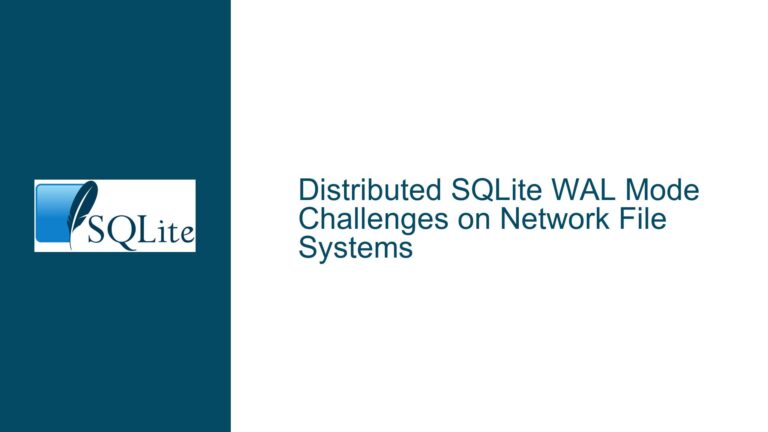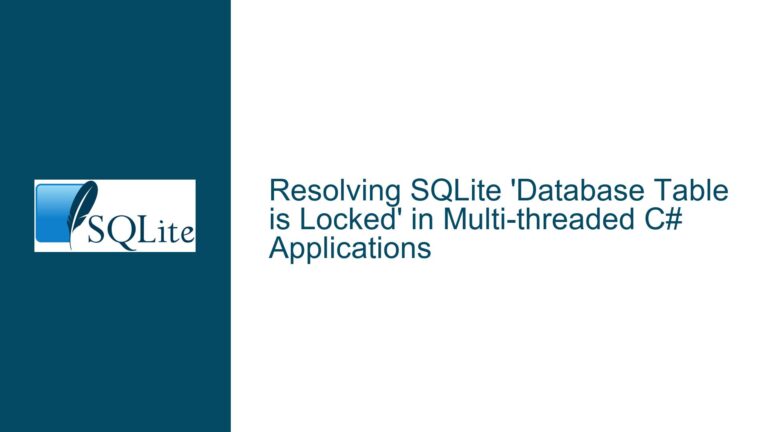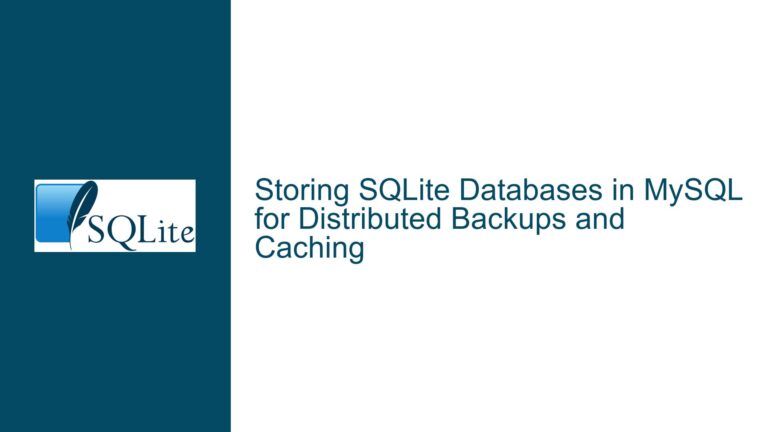Optimizing SQLite Connection Strategies for Multithreaded Servers
SQLite Connection Strategies in Multithreaded Environments
When designing a multithreaded server that interacts with an SQLite database, one of the critical decisions is how to manage database connections. The choice between using one connection per thread or a single shared connection across multiple threads has significant implications for performance, data integrity, and concurrency. SQLite, being a lightweight, serverless database engine, offers unique challenges and opportunities in this context. The decision is further complicated when using advanced features like WAL2 mode, which can influence read/write parallelism and transaction isolation.
In a typical multithreaded server, each thread may need to perform database operations independently. The traditional approach is to assign a dedicated SQLite connection to each thread. This strategy ensures that each thread operates in isolation, with its own transaction context, and avoids contention between threads. However, this approach can lead to resource overhead, as each connection consumes memory and other system resources. Additionally, the number of concurrent connections may be limited by the underlying system or SQLite’s configuration.
On the other hand, sharing a single SQLite connection across multiple threads can reduce resource consumption and potentially improve performance by reusing the same connection. However, this approach introduces significant challenges related to transaction management and isolation. SQLite’s default threading mode is serialized, meaning that only one thread can execute SQLite operations at a time. While SQLite supports multithreaded mode, where multiple threads can execute operations concurrently, this mode requires careful handling of transactions to avoid conflicts and ensure data integrity.
The choice between these strategies is not merely a matter of performance but also involves considerations of ACID (Atomicity, Consistency, Isolation, Durability) properties. In particular, the isolation level of transactions can be compromised when sharing a connection, leading to potential data anomalies. Furthermore, the use of WAL2 mode, which enhances write-ahead logging, adds another layer of complexity. WAL2 mode allows readers and writers to operate concurrently, but this concurrency is limited by the number of connections and the way transactions are managed.
In summary, the decision to use one connection per thread or a single shared connection in a multithreaded server involves a trade-off between resource efficiency and transaction isolation. The optimal strategy depends on the specific requirements of the application, including the level of concurrency, the nature of the transactions, and the desired balance between performance and data integrity.
Transaction Isolation and Resource Contention in Shared Connections
When considering the use of a single shared SQLite connection across multiple threads, one of the primary concerns is transaction isolation. SQLite’s transaction model is designed to ensure that each transaction is executed in isolation from others, providing a consistent view of the database. However, when multiple threads share a single connection, this isolation can be compromised, leading to potential data anomalies and inconsistencies.
In a shared connection scenario, all threads operate within the same transaction context. This means that any changes made by one thread are immediately visible to other threads, even before the transaction is committed. This lack of isolation can lead to dirty reads, where a thread reads uncommitted changes from another thread, or non-repeatable reads, where a thread sees different results for the same query within the same transaction. Additionally, if one thread rolls back a transaction, all changes made by other threads within that transaction will also be rolled back, leading to an undefined and potentially inconsistent state.
Another significant issue with shared connections is resource contention. SQLite’s default threading mode is serialized, meaning that only one thread can execute SQLite operations at a time. While SQLite supports multithreaded mode, where multiple threads can execute operations concurrently, this mode requires careful handling of transactions to avoid conflicts. In a shared connection scenario, threads may contend for access to the connection, leading to potential bottlenecks and reduced performance. This contention can be exacerbated in high-concurrency environments, where multiple threads are frequently accessing the database.
The use of WAL2 mode can mitigate some of these issues by allowing readers and writers to operate concurrently. However, this concurrency is limited by the number of connections and the way transactions are managed. In a shared connection scenario, the benefits of WAL2 mode may be negated by the lack of transaction isolation and the potential for resource contention. Furthermore, overlapping readers can indefinitely prevent changes from being committed, leading to potential issues with WAL file size and disk space usage.
In summary, sharing a single SQLite connection across multiple threads introduces significant challenges related to transaction isolation and resource contention. These challenges can lead to data anomalies, reduced performance, and potential issues with WAL file management. Therefore, it is generally recommended to use dedicated connections per thread, allowing SQLite to handle concurrency and transaction isolation internally.
Implementing Dedicated Connections and WAL2 Mode for Optimal Performance
To achieve optimal performance and ensure data integrity in a multithreaded server using SQLite, it is generally recommended to use dedicated connections per thread. This approach allows each thread to operate independently, with its own transaction context, and avoids the issues associated with shared connections. Additionally, the use of WAL2 mode can enhance concurrency and improve performance by allowing readers and writers to operate concurrently.
When implementing dedicated connections per thread, it is important to manage the lifecycle of each connection carefully. Each thread should create its own SQLite connection when it starts and close the connection when it terminates. This ensures that each thread has exclusive access to its connection and avoids potential resource leaks. Additionally, it is important to configure each connection appropriately, including setting the desired journal mode (e.g., WAL2) and ensuring that the connection is properly initialized.
The use of WAL2 mode can significantly enhance the performance of a multithreaded server by allowing readers and writers to operate concurrently. In WAL2 mode, changes are written to a separate write-ahead log file, allowing readers to continue accessing the database without being blocked by writers. This can lead to improved throughput and reduced latency, particularly in high-concurrency environments. However, it is important to monitor the size of the WAL file and ensure that it does not grow excessively, as this can lead to disk space issues.
To further optimize performance, it is recommended to use prepared statements and parameterized queries. Prepared statements allow SQLite to compile and optimize queries in advance, reducing the overhead of query execution. Parameterized queries help prevent SQL injection and improve performance by allowing SQLite to reuse query plans. Additionally, it is important to use transactions appropriately, grouping related operations into a single transaction to reduce the overhead of committing changes.
In summary, implementing dedicated connections per thread and using WAL2 mode can significantly enhance the performance and data integrity of a multithreaded server using SQLite. By carefully managing the lifecycle of each connection, configuring the appropriate journal mode, and optimizing query execution, it is possible to achieve a high level of concurrency and throughput while maintaining the ACID properties of the database.
Conclusion
In conclusion, the choice between using one connection per thread or a single shared connection in a multithreaded server using SQLite involves a trade-off between resource efficiency and transaction isolation. While sharing a single connection can reduce resource consumption, it introduces significant challenges related to transaction isolation and resource contention. These challenges can lead to data anomalies, reduced performance, and potential issues with WAL file management.
To achieve optimal performance and ensure data integrity, it is generally recommended to use dedicated connections per thread. This approach allows each thread to operate independently, with its own transaction context, and avoids the issues associated with shared connections. Additionally, the use of WAL2 mode can enhance concurrency and improve performance by allowing readers and writers to operate concurrently.
By carefully managing the lifecycle of each connection, configuring the appropriate journal mode, and optimizing query execution, it is possible to achieve a high level of concurrency and throughput while maintaining the ACID properties of the database. This approach provides a robust and scalable solution for multithreaded servers that require efficient and reliable access to an SQLite database.






